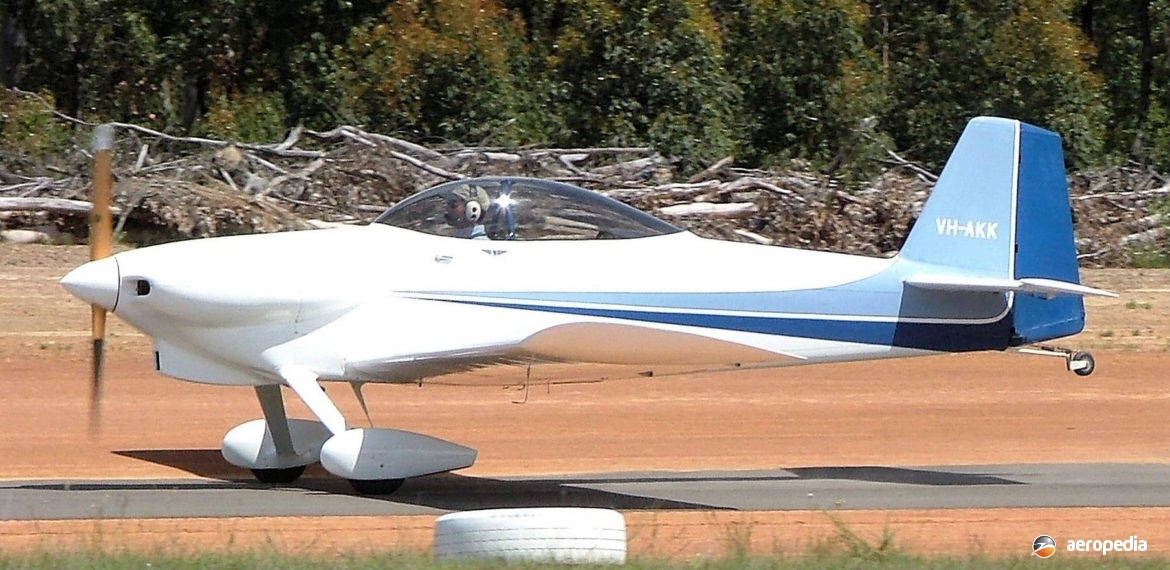Photograph:
Vans RV-4 VH-AKK (c/n N147) at Wedderburn, NSW in August 2012 (David C Eyre)
Country of origin:
United States of America
Description:
Two-seat light sport monoplane
Power Plant:
One 112 kw (150 hp) Avco Lycoming O-320-E1F four-cylinder horizontally- opposed air-cooled engine
Specifications:
- Wingspan: 7.01 m (23 ft)
- Length: 6.21 m (20 ft 4½ in)
- Height: 1.6 m (5 ft 3 in)
- Wing area: 10.22 m² (110 sq ft)
- Max speed at sea level: 323 km/h (201 mph)
- Max cruising speed at 2,440 m (8,000 ft): 299 km/h (186 mph)
- Economical cruising speed at 55% power at 2,440 m (8,000 ft): 284 km/h (164 mph)
- Stalling speed: 87 km/h (54 mph)
- Max rate of climb at sea level: 503 m/min (1,650 ft/min)
- Service ceiling: 5,945 m (19,500 ft)
- Range with max fuel at 55% power: 1,287 km (800 miles)
- Empty weight: 404 kg (890 lb)
- Loaded weight: 680 kg (1,500 lb)
History:
The RV-4 was a development of the single-seat RV-3 and was also designed by Richard Van Grunsven of Oregon, USA. It seated two in tandem and was similar in external appearance to the RV-3 but was some 20% larger. There was no commonality of airframe components, the design goal being only to retain the flight characteristics and overall performance of the RV-3.
The prototype of the RV-4 (N14RV) was first flown on 21 August 1979 and since then a large number of kits has been sold to home-builders throughout the world. The wing was of light alloy construction of constant chord with an I-beam main spar, a light rear spar, pressed ribs and moulded fibreglass tips. All-metal Frise-type ailerons were fitted. The fuselage was of all-metal semi-monocoque structure using 2024-T3 light alloy, and a fibreglass engine cowl was fitted. The tail unit was of cantilever structure of light alloy with fibreglass tips. Fuel capacity was 121 litres (26.6 Imp gals) and accommodation was provided for two with a baggage compartment forward of the instrument panel, and another aft of the rear seat, with a total capacity of 12.6 kg (30 lb). Further development of the RV-4 led to the RV-6, the prototype of which was flown in April 1977, and the RV-8.
More than 45 examples of the RV-4 series have been registered in Australia and six in New Zealand. First RV-4 completed in this region was VH-NRV (c/n N123) by Jon Johanson. On 29 January 1995 he flew from Adelaide, SA to Auckland, NZ in 13 hrs 57 mins against headwinds, covering 3,350 km (2,082 miles). Jon also flew the aircraft to Malaysia, twice to New Zealand, and twice around the world, once in each direction. As part of one of the latter trips he flew to the United States, visiting the Experimental Aircraft Associations annual event at Oshkosh in Wisconsin, in July 1995. Longest stage was 15 hrs from Hawaii to the US West Coast. He also set a new record for the London, UK to Melbourne, VIC flight, taking ten days off the previous FAI Class 1.b record set in a Thorp T-18.
Another RV-4 Exxon Flyin’ Tiger flown by Bruce Bohannon in the United States set a number of altitude and time records in its weight class (Class 1.b) and claimed nine records in the Unlimited Class. In 1995 it broke the 9,000 m (29,528 ft) Time to Climb World Record, cutting nearly ten minutes off the old time. After turbo-charging and other modifications, a further two minutes was taken off the aircraft’s own record, reducing the time to 15 mins 32 secs. On 17 April 2004 he climbed to 9,144 m (30,000 ft) in 9 mins 51 secs and indicated an intention to eventually set a record to 15,240 m (50,000 ft).

